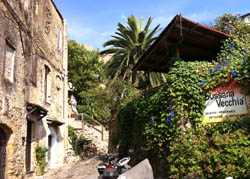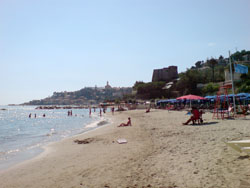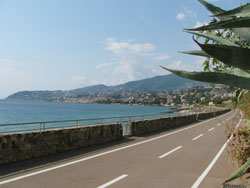The 'Antico Borgo di Bussana' is one of the key tourist attractions along the Ligurian coast. It was built between the 11th and 15th century, likely by local fishermen moving uphill to protect themselves from pirate attacks. These pirate attacks by Saracene/Berber pirates continued up to 1800. Once a a year, or whenever it pleased them, the pirate ships did their 'round' along the Italian coast to take slaves, cattle, and any other merchandise. The local population built watch towers to spot them so they could hide (or fight) in time. Along the South coast of Sicily you can still find over fifty of them. In our part of Liguria there are at least a dozen.
Local population was captured and sold at the slave markets in Tunis and Morocco. This happened to one of the remote family members of Napoleon Bonaparte around 1750. A little girl (Martha Franceschini) ended up at the harem of the sultan of Morocco and eventually became empress. The Bonaparte family originally came from Liguria and later moved to Corsica.
The fishermen along the Ligurian coast built several rings of houses around the Bussana hilltop castle dating from the 7th or 8th century. While architecture in main European cities turned to gothic style, this small town was built using ancient roman construction practices making it a unique historic location. They also built a watchtower along the street towards the castle.
A series of earthquakes destroyed the church and damaged many homes in the upper area of town in 1887. The village already was hit by earthquakes in 1831 (with forty-nine houses badly damaged) and a series of shocks in 1854, which led to the collapse of the big watchtower. In the afternoon of the 1887 earthquake the inhabitants were forced to leave their town at gunpoint by soldiers and were not allowed to rescue their family members that were still alive under the rubble. A total of 55 inhabitants died: 52 in the upper part (Rocche and Monta) part of town, and three in church when the roof collapsed on this Ash-Wednesday in February 1887. Of this total, some twenty died because nobody was allowed to rescue them.
Since only about one-third of the town was destroyed, the villagers expected to return after restoration work, as was the case with all other nearby towns that were destroyed.
In the case of Bussana, the local authorities decided, probably with lucrative business in mind, to build a new town further down the hill: Bussana Nuova.
The inhabitants had to live in tents for weeks, then in drafty barracks for seven years, for which they had to pay rent, and eventually had to move to the new town which was built with the money from the inhabitants. When a significant part of the population refused to leave, the municipality of Sanremo ordered destruction of their homes and cut the water supply to town.
The town remained deserted until the second world war, when it was used by the nazi's as base. In the 1950's, a group of about 70 poor immigrant families from Calabria who found jobs in the flower industry, started to remove the rubble and moved in. Displeased with these immigrants, the municipality ordered their eviction and decided to destroy all first and second floors and stairways in the houses with dynamite, rendering it completely uninhabitable.
Please check my pages on this website with excerpts from the book by historian Nilo Calvini (English and Italian).
Less dramatic events have resulted in Hollywood motion pictures...
In fact, multiple films have been recorded in Bussana Vecchia.
Here is an 8-minute clip of the 1951 British thriller 'I'll get you for this' with George Raft and Coleen Gray. It was partially shot in Bussana Vecchia in 1949, and released in 1951. The two scenes show that many buildings were still existing in 1949, and only destroyed when the Genio Civile used dynamite (invented by Alfred Nobel, who had his luxury villa nearby in Sanremo) in the early '50s to expel poor immigrant workers from the South of Italy.
In the above image, the arched window just left above George Raft's head was part of what used to be my top floor. Thanks to the demolitions some time later it collapsed and now forms the West side of my terrace.
Despite the ruin state of the town, an international artist community started to live there in the 1960's. Bussana Vecchia presently consists of some hundred fifty houses in various states of restauration. All repairs as well as the streets, and the sewer and water installs have been funded by the resident artist population. Government funding was never provided.
For the last fifty years there have been legal battles about ownership with the government and various other Italian authorities who claim the village is theirs. Progress is close to zero. A recent discussion between the State Property authorities and the city of Sanremo has led to substantial publicity. Check the Bussana Vecchia Resilient pages on Facebook with information and newspaper articles (in Italian).
In the mean time, the multiple threats by the local authorities and the government means that artists are struggling to maintain a decent income. Very few of the orginal 'hippie' artists regularly come to Bussana. Most have passed away, and their galleries are now in use by new artists. In Winter, the town is only visited by some hikers and a few French tourists. There's a peak near Easter, and North European school holidays. Tourism become more visible from late May onwards, so that is the time when artists start presenting the art- and craft works they created during wintertime in the galleries.
One of the most faithful artists, Massimiliano, works in the small gallery underneath our house. He creates metal artworks from scrap metal, hence the name Recicl' Art.

The government decided that this town, which was for the most part destroyed by the state, is now of key historic interest and have drafted a rather ridiculous plan to turn the town into a Disney-like attraction. As always, investors, builders, and other greedy parties are involved, with a goal to obtain a 44 million euro amount from the European Union.
First activity: evict the inhabitants, so they served the inhabitants fines of up to more than 100,000 euro per apartment for "illegal usage". This action is equally devastating for the inhabitants as the cutting of the water supply was in 1892. Over one hundred legal actions against the plans of the state are now in progress. Please read more in the pages dedicated to the Demanio (English and Italian).
During late 2018 and early 2019 I worked on a documentary film with my friend Leonard Sommer and the Royal Film company. This documentary makes use of the books by professor Nilo Calvini and many other historic and photographic evidence to present an accurate view of the events in old Bussana between the 1887 earthquake and recent eviction plans by the government. The story is told by the young people who were born and raised in Bussana Vecchia, plus few other inhabitants including yours truly to provide historic details. The film has been submitted to several renowned documentary festivals. See the Bussana Resilient Art in Ruins documentary overview webpage. Awaiting formal translations by the film company, I drafted versions on Youtube with English and Italian subtitles.
You'll still find many artists with small galleries and workshops in town, as well as several restaurants and pubs that are highly popular with both local and international tourists, especially during summer and in weekends. My friend Larry stayed at the house in June 2014 and made this nice b/w presentation of the village on Youtube.
The town is located on a hilltop at 180m altitude at the Rivièra dei Fiori. It is half an hour drive to the French border and Monaco and a 60 minute drive from Nice airport (it used to be 50 minutes, but the many speed traps on the French side require extra caution and time...).
It overlooks some of the finest beaches along the Italian/French coastline. The town belongs to the city of Sanremo which is 7 km to the West.
For bike enthusiasts: the village is directly opposite the famous "Poggio" hill known from the Milan - Sanremo cycle race
The old railway along this part of the coast has been transformed into a beautiful path, pista ciclabile, exclusively for walking and biking.
From the village it takes 10 minutes (either by bike or by car) to go to the coastal road (the classic Via Aurelia) and the beach. Hikers can follow the mule-path down to Bussana Nuova. The stroll downwards will be less than 25 minutes, going up takes 5-10 minutes more. See the Mulatteria image or the Google Earth route for the donkey footpath down to the beach (2.0 km). Note: this is a kmz zipfile; download via Rightclick "Save target As.". and open in Google Earth.
Jogging down to the beach (Casaccia resaturant to Daruma Beach via the road, with small shortcut behind house at Beuzi intersection, and long stairway in Bussana Nuova) takes about 15 minutes, going up takes five minutes extra. Jogging uphill is, in fact, a little faster than biking.
If you are a competitive type: My 2024 fastest downrun Casaccia - Daruma was 13min42sec. Fastest run up Daruma - Casaccia was 19min 24sec. Eager to learn your fastest runs.
For completion sake: With an Airwheel, the trip duration in either direction is 16 minutes.
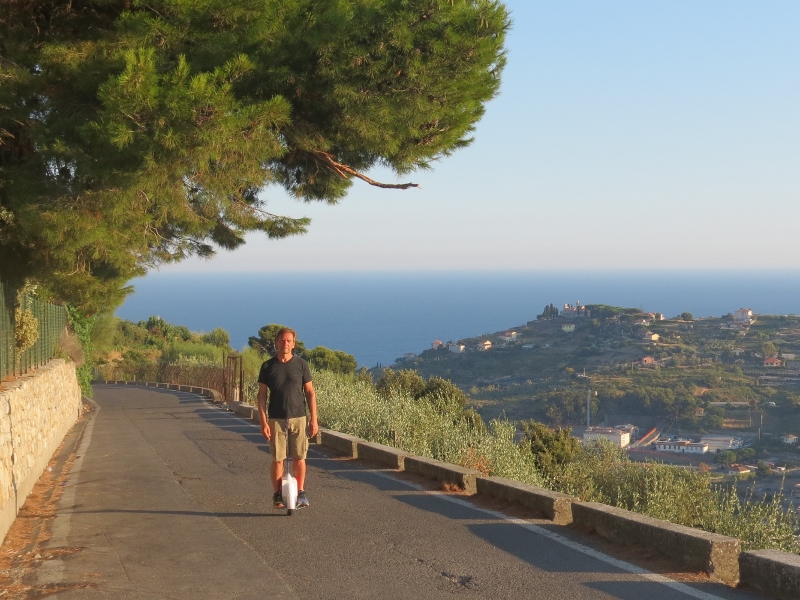
You'll find basic shops and some restaurants in Bussana Nuova, a Carrefour supermarket at the Via Aurelia coastal road and a few minutes more you'll find large shopping areas (Conad, Super-Carrefour) as well as many small quality food stores in the beach town Arma di Taggia.
 The house is located in the picturesque main street of the village, formerly called Via Vallao, which is on your left hand side when you enter the village (at the Piazzetta Golosa bar). The name Via Vallao probably relates to the ancient roman footpath that starts at the bottom of our stairs, under the arch, down into the Armea valley and Sanremo. CasaJoan is located a 10 meters (30 ft) from the Piazzetta Golosa bar, on the right side of the street at the point where it expands into into a little square.
The house is located in the picturesque main street of the village, formerly called Via Vallao, which is on your left hand side when you enter the village (at the Piazzetta Golosa bar). The name Via Vallao probably relates to the ancient roman footpath that starts at the bottom of our stairs, under the arch, down into the Armea valley and Sanremo. CasaJoan is located a 10 meters (30 ft) from the Piazzetta Golosa bar, on the right side of the street at the point where it expands into into a little square.
Take the left side of the double stairway to the entrance of CasaJoan. The door on the right side on the top of the stairs leads to the house of my friend Ivana who manages the house in my absence.
Notice that street names or home numbers do not exist in Bussana Vecchia. The houses were reconstructed by the local artist community in a spontaneous effort and, as a consequence, were not registered by the authorities with postal code and address. Mail is only brought to mailboxes at the entrance of town. All streets did have names before the town was abandoned in 1887, and my preference is to continue using these official names. You won't find the street names on car navigation systems, but they have been accepted by the Google Maps designers.
The living room offers a splendid view of the lively main street lined with art shops and many tourists. See this image for house location and parking indications.There's free parking all along the main street except for the areas marked in red, which are turning/manovra zones. Since the street is a dead-end street ending at the entrance of the old town you may place your car at the very end of the street for several minutes for any necessary (un)loading.
Between Spring and Autumn there's always something to see in town. It is a dozen steps away from excellent Piazzetta Golosa breakfast/lunch/aperitivo place (managed by our dear friends Lucca/Monica and Gianluca/Roberta) and a few more steps take you to the Osteria of the artists of Bussana Vecchia. The terrace offers a magnificent view of the town and the sea.
Interesting links
- Bussana Resilient Art In Ruins
-> Youtube links about Bussana (English & Italian)
- Villagio Internazionale degli Artisti (2010)
- Italian premiere of Canto Ostinato for harp by Assia Cunego
- Bussana Vecchia Resilient Facebook pages
- Nilo Calvini historic information
- My comments on the State development plan to Disneyfy our town
- Bussana Street Music (with hang drum, an pentatonic instrument that was inspired Swiss cow bells)
History
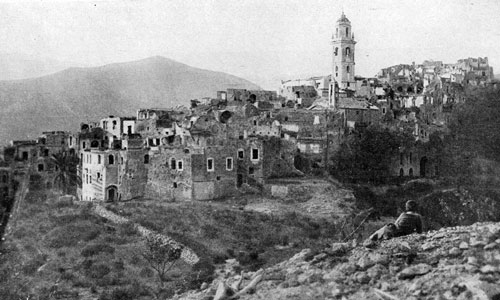
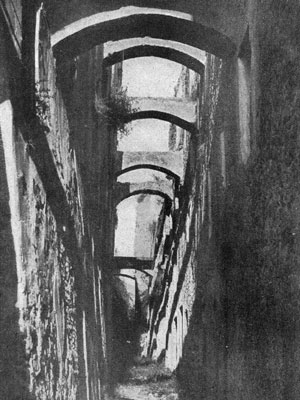
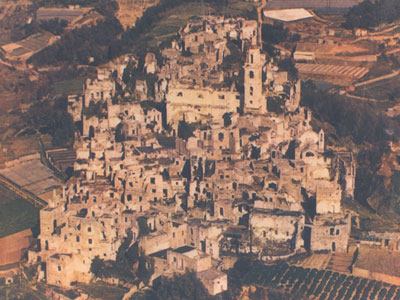
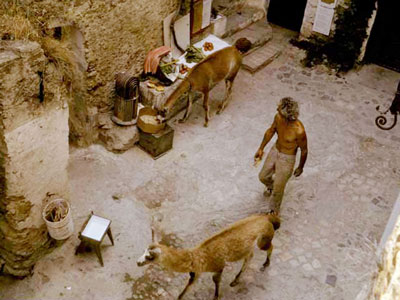
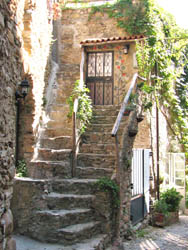
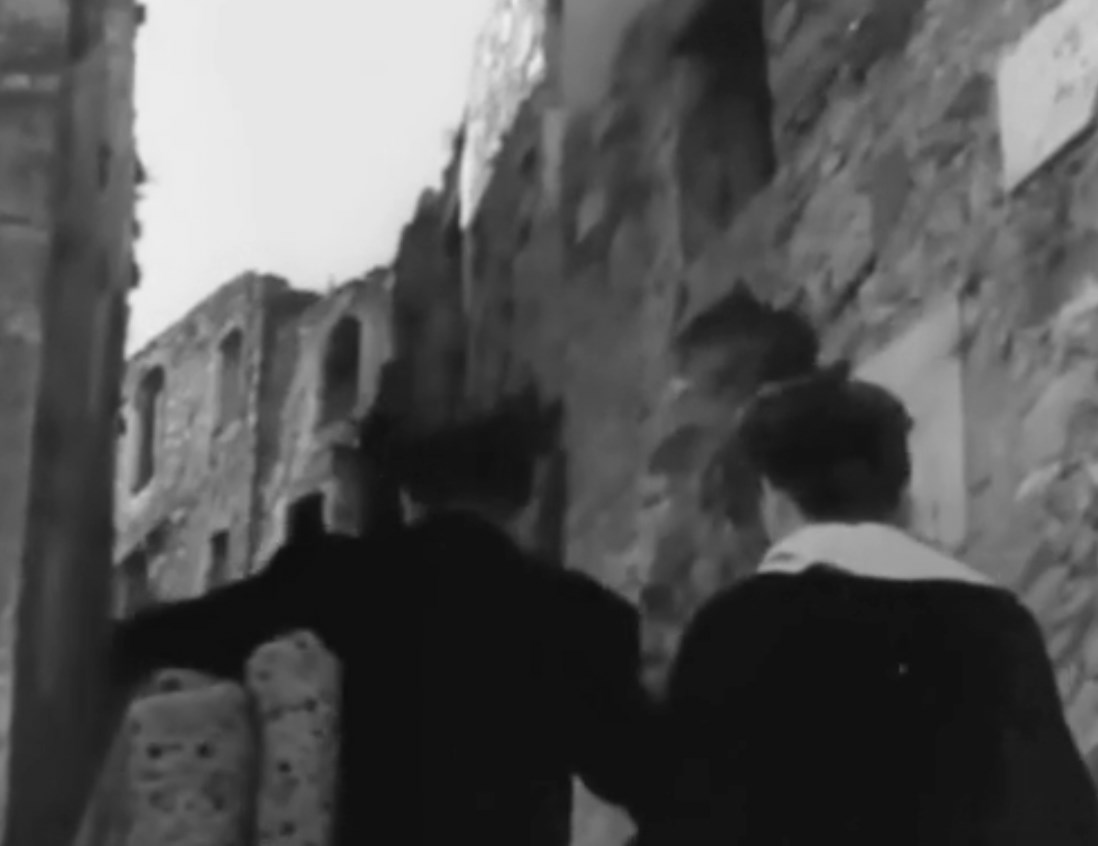
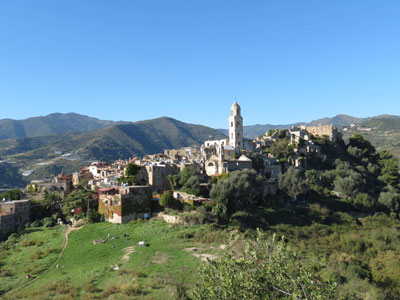
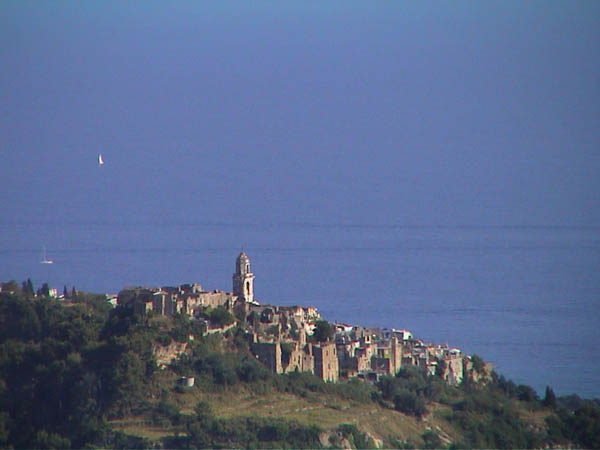
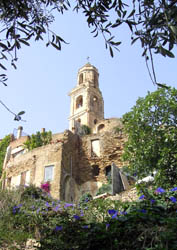
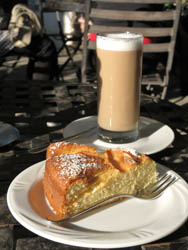
.jpg)
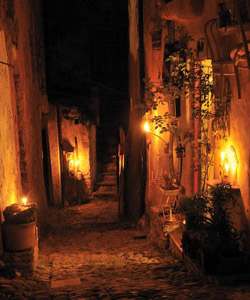

.jpg)
